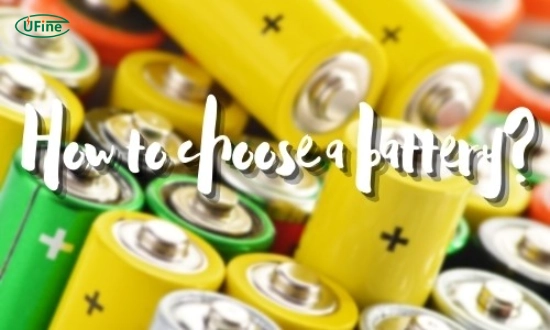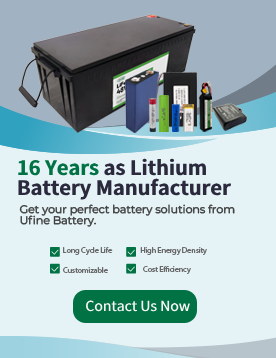
- Part 1. Understanding flashlight battery sizes and types
- Part 2. Flashlight battery size comparison chart
- Part 3. How to measure flashlight battery size ?(Quick Steps)
- Part 4. Detailed breakdown of flashlight battery sizes
- Part 5. Choosing tips for flashlight batteries
- Part 6. FAQs about flashlight battery sizes
Flashlight Battery Sizes & Chart — What Size Batteries Do Small Flashlights Use?
Quick answer: Small flashlights commonly use AA, AAA, 14500 (3.7V) or 16340/CR123A cells — check the flashlight’s required voltage and the compartment length before choosing. Typical dimensions: 14500 = 14×50mm, 16340 ≈16×34mm.
- Voltage matters: 14500/16340/18650 are ~3.6–3.7V (lithium). AA/AAA (NiMH/alkaline) are ~1.2–1.5V per cell.
- Fit first, capacity second: Measure compartment with calipers — ±0.5mm tolerance is usually acceptable.
- Rechargeables: Use protected cells for high-drain lights unless the device supports unprotected cells safely.
At a glance: 14500 (14×50mm), 16340 (16×34mm), 18650 (18×65mm), 26650 (26×65mm).
Part 1. Understanding flashlight battery sizes and types
Flashlight batteries come in three primary categories: Lithium Batteries, NiMH Batteries, and Other types. Each type offers distinct advantages and is suitable for different applications.
- Lithium Batteries: Known for their high energy density and long shelf life, lithium batteries are a popular choice for flashlights. They come in various sizes, including 18650, 26650, 21700, and more.
- NiMH Batteries: Nickel-metal hydride batteries are rechargeable and offer a cost-effective solution for flashlight users. Standard sizes include AA, AAA, C, D, and 9V block batteries.
- Other types of flashlight batteries: This category includes alternative battery options such as 6V and 12V block batteries and the smaller 4LR44, also known as AG13.
Part 2. Flashlight battery size comparison chart
The table below lists common flashlight battery sizes and typical capacities to help you quickly match your flashlight model.
| Battery Size | Diameter (mm) | Length (mm) | Voltage (V) | Capacity Range (mAh) | Best For |
|---|---|---|---|---|---|
| 10180 | 10 | 18 | 3.7 | 70–120 | Micro/keychain lights |
| 14500 | 14 | 50 | 3.7 | 600–1000 | Mini flashlights |
| 16340 / RCR123A | 16 | 34 | 3.0–3.7 | 600–1000 | Compact flashlights |
| 18350 | 18 | 35 | 3.7 | 800–1200 | Short-profile EDC lights |
| 18650 | 18 | 65 | 3.7 | 2500–3500 | EDC / Tactical |
| 21700 | 21 | 70 | 3.7 | 3500–4500 | EDC / Bike lights |
| 26650 | 26 | 65 | 3.7 | 4000–5000 | Search / Outdoor lights |
| AA (NiMH) | 14.5 | 50.5 | 1.2–1.5 | 2000–3000 | Household flashlights |
| AAA (NiMH) | 10.5 | 44.5 | 1.2–1.5 | 600–1000 | Headlamps / small lights |
| D Cell (NiMH) | 34.2 | 61.5 | 1.2–1.5 | 5000–10000 | Lanterns / high-capacity lights |
Pro Tip: Measure the battery compartment with digital calipers — a ±0.5mm tolerance is usually acceptable.
Part 3. How to measure flashlight battery size ?(Quick Steps)
Prepare tools
Use digital calipers that measure in millimeters.
Measure diameter
Record the narrowest inside width of the battery compartment.
Measure length
Measure the depth of the battery tube (excluding springs or contacts).
Match the code
Compare with common codes (e.g., 18650 = 18×65mm) to confirm type and voltage.
Tip: Always follow the flashlight manufacturer’s voltage recommendations — never replace 1.2V NiMH cells with 3.7V lithium cells unless supported.
Part 4. Detailed breakdown of flashlight battery sizes
1 Lithium Batteries:
18650 battery
- Specifications: The popular 18650 battery size (18mm × 65mm), with a voltage of 3.7V and a capacity typically ranging from 2500mAh to 3500mAh.
- Features: 18650 batteries, known for their high energy density and long lifespan, are ideal for high-performance flashlights.
- Suitability: Ideal for tactical flashlights, high-powered LED flashlights, and other devices requiring long runtime and high output.
26650 battery
- Specifications: The 26650 battery is more extensive, with a diameter of 26mm and a length of 65mm, offering a voltage of 3.7V and a capacity typically ranging from 4000mAh to 5000mAh.
- Features: These batteries provide higher capacity and longer runtime, making them suitable for heavy-duty flashlights.
- Suitability: Commonly used in searchlights, high-lumen flashlights, and powerful handheld spotlights for outdoor activities.
21700 battery
- Specifications: The 21700 battery measures 21mm in diameter and 70mm in length, with a voltage of 3.7V and a capacity typically ranging from 3500mAh to 4500mAh.
- Features: 21700 batteries, which balance capacity and performance, are increasingly popular in modern flashlight designs.
- Suitability: It is suitable for everyday carry (EDC) lights, bike lights, and tactical flashlights requiring a smaller form factor.
16340 (CR123A) battery
- Specifications: The 16340 battery, also known as CR123A, has a diameter of 16mm and a length of 34mm. Its voltage typically ranges from 3.0V to 3.7V, and its capacity varies from 600mAh to 1000mAh.
- Features: CR123A batteries offer high voltage and excellent shelf life, making them ideal for devices requiring long-term storage or infrequent use.
- Suitability: Commonly used in compact flashlights, weapon-mounted lights, and surveillance cameras due to their small size and high energy output.
14500 battery
- Specifications: The 14500 battery has a diameter of 14mm and a length of 50mm. It provides a voltage of 3.7V and a capacity typically ranging from 600mAh to 1000mAh.
- Features: Similar in size to AA batteries, 14500 lithium batteries offer higher voltage and energy density, making them suitable for compact flashlights with demanding power requirements.
- Suitability: Ideal for mini flashlights, penlights, and keychain lights where space is limited but performance is essential.
18350 battery
- Specifications: The 18350 battery has a diameter of 18mm and a length of 35mm. Its voltage is 3.7V, and its capacity typically ranges from 800mAh to 1200mAh.
- Features: Despite their shorter length, 18350 batteries offer decent capacity and power output, making them suitable for compact flashlight designs without sacrificing performance.
- Suitability: Commonly used in small and medium-sized flashlights, especially those requiring a shorter form factor for portability or concealment.
10180 battery
- Specifications: The 10180 battery is ultra-compact, measuring 10mm in diameter and 18mm in length, with a voltage of 3.7V and a capacity typically ranging from 70mAh to 120mAh.
- Features: Despite their small size, 10180 batteries offer compactness and convenience. They are suitable for micro flashlights and keychain lights where space is limited.
- Suitability: This material is suitable for pocket-sized flashlights, emergency lights, and keychain flashlights where space is limited but occasional use is expected.
CR2 battery
- Specifications: CR2 batteries have a diameter of 15.6mm and a length of 27mm. Their voltage typically ranges from 3.0V to 3.2V, and their capacity varies from 600mAh to 900mAh.
- Features: CR2 batteries offer a combination of small size and decent capacity, making them suitable for specific flashlight designs.
- Suitability: Commonly used in laser pointers, digital cameras, and specific types of flashlights requiring a compact yet powerful energy source.
CR2450 battery
- Specifications: CR2450 batteries are coin cell batteries with a diameter of 24.5mm and a thickness of 5mm. They provide a voltage of 3.0V and a capacity typically ranging from 600mAh to 700mAh.
- Features: Despite their small size, CR2450 batteries offer sufficient capacity for specific flashlight applications.
- Suitability: Occasionally used in speciality flashlights, keychain lights, and electronic devices where space is limited and power consumption is relatively low.
2 NiMH Batteries:
AA (HR6) battery
- Specifications: AA batteries have a diameter of 14.5mm and a length of 50.5mm, provide a voltage of 1.2V, and typically have a capacity ranging from 2000mAh to 3000mAh.
- Features: NiMH AA batteries are rechargeable and offer good capacity and performance, making them a cost-effective and eco-friendly choice for flashlight users.
- Suitability: It is suitable for a wide range of flashlight models, including everyday carry lights, camping lanterns, and household flashlights requiring AA batteries.
AAA (HR03) battery
- Specifications: AAA batteries have a diameter of 10.5mm and a length of 44.5mm, providing a voltage of 1.2V and a capacity typically ranging from 600mAh to 1000mAh.
- Features: AAA batteries are minor compared to AA batteries but offer similar performance and compatibility with rechargeable NiMH technology, making them suitable for compact flashlight designs.
- Suitability: Commonly used in mini flashlights, headlamps, and small electronic devices where limited space and lightweight power sources are required.
C (HR14) battery
- Specifications: C batteries have a diameter of 26.2mm and a length of 50mm, providing a voltage of 1.2V and a capacity typically ranging from 2500mAh to 4500mAh.
- Features: NiMH C batteries offer higher capacity and longer runtime than AA and AAA batteries, making them suitable for larger flashlights and devices with higher power requirements.
- Suitability: It is ideal for heavy-duty flashlights, camping lanterns, and emergency lights where long-term use and reliability are essential.
D (HR20) battery
- Specifications: D batteries have a diameter of 34.2mm and a length of 61.5mm. They provide a voltage of 1.2V and a capacity typically ranging from 5000mAh to 10000mAh.
- Features: D batteries are the largest among standard NiMH batteries. They offer the highest capacity and longest runtime, making them suitable for high-power flashlights and devices requiring sustained energy output.
- Suitability: Commonly used in industrial flashlights, emergency lighting systems, and outdoor lanterns where durability and performance are paramount.
9V block battery
- Specifications: 9V batteries are rectangular, measuring approximately 26.5mm x 17.5mm x 48.5mm. They provide a 9V voltage and a capacity typically ranging from 400mAh to 600mAh.
- Features: Devices requiring multiple cells or compact power sources commonly use 9V block batteries, which provide high voltage.
- Suitability: This product is suitable for specific flashlight models, smoke detectors, wireless microphones, and other devices requiring a reliable and long-lasting power supply.
3 Other types of flashlight batteries:
6V block battery
- Specifications: 6V block batteries typically have dimensions of approximately 34mm x 17mm x 67mm, providing a voltage of 6V and a capacity normally ranging from 4000mAh to 8000mAh.
- Features: 6V block batteries offer higher voltage than standard AA or AAA batteries, making them suitable for specific flashlight models and devices requiring higher power output.
- Suitability: It is commonly used in older flashlight designs, portable spotlights, and emergency lighting systems where compatibility with 6V power sources is essential.
12V block battery
- Specifications: 12V block batteries have dimensions of approximately 34mm x 17mm x 67mm, provide a voltage of 12V, and typically have a capacity ranging from 3000mAh to 6000mAh.
- Features: 12V block batteries provide even higher voltage than 6V batteries, making them suitable for specific flashlight models and devices requiring 12 volts of power.
- Suitability: Used in specialized flashlights, vehicle-mounted lights, and other applications where higher voltage is necessary for optimal performance.
4LR44 (AG13) battery
- Specifications: 4LR44 batteries are button cell batteries with a diameter of 11.6mm and a thickness of 5.4mm. They provide a voltage of 1.5V and a capacity typically ranging from 100mAh to 200mAh.
- Features: Despite their small size, 4LR44 batteries offer sufficient voltage and capacity for specific flashlight applications.
- Suitability: Occasionally used in compact flashlights, keychain lights, and electronic devices requiring a low-profile power source.
4 Match Battery Size to Your Flashlight Type
- EDC Pocket Lights: 16340 or 14500 sizes (compact dimensions)
- Tactical Flashlights: 18650 (balance of power/size)
- Search & Rescue Lights: 26650 or dual 18650 (max runtime)
- Headlamps: AAA or proprietary flat packs (lightweight)
Part 5. Choosing tips for flashlight batteries
- Understand Your Flashlight’s Requirements: Before choosing a battery, it’s essential to understand your flashlight’s specifications, including its voltage, size, and power consumption.
- Consider Battery Chemistry: Flashlight batteries use various chemistries, such as lithium-ion, nickel-metal hydride (NiMH), and alkaline.
- Evaluate Voltage and Capacity: Pay attention to the battery’s voltage and capacity, as these factors directly impact the flashlight’s runtime and performance. Higher voltage batteries generally provide more power, while higher capacity batteries offer longer runtime between charges or replacements.
- Check Size and Form Factor: Using a battery that is too large or too small may result in poor fitment or damage to the flashlight.
- Consider Rechargeable Options: Rechargeable batteries can be a cost-effective and eco-friendly choice for frequent flashlight users. Consider investing in rechargeable lithium-ion or NiMH batteries and a compatible charger for long-term savings and convenience.
- Check Compatibility: Some flashlights only work with specific battery types or brands, as their design dictates. Check the manufacturer’s recommendations to ensure compatibility and avoid damaging your flashlight.
- Evaluate Environmental Conditions: Consider the environmental conditions in which you’ll use your flashlight. For extreme temperatures or outdoor activities, choose batteries with high-performance ratings and durability to withstand harsh conditions.
- Consider Long-Term Costs: Rechargeable batteries may have a higher upfront cost, but they can save money in the long run compared to disposable batteries.
Part 6. FAQs about flashlight battery sizes
What are the standard flashlight battery sizes and uses?
Common sizes: AA (household), AAA (headlamps), 18650 (tactical), CR123A/16340 (compact), D (lanterns).
18650 vs 26650 batteries: capacity and suitability
26650 typically delivers 30–40% more capacity (4000–5000mAh) vs 18650 (2500–3500mAh) — choose 26650 for longest runtime and 18650 for better balance of size and portability.
How to measure flashlight battery size?
To measure flashlight battery size accurately: First, measure the diameter in millimeters using digital calipers. Second, measure the length excluding terminals and springs. Finally, match the numeric code to standard sizes (e.g., 18650 = 18×65mm).
Can I use AA batteries instead of 14500?
No. AA is nominal 1.2–1.5V; 14500 is 3.7V — voltage mismatch can damage electronics.
Which batteries are best for small flashlights?
Small flashlights: AA, AAA, 14500, or 16340. Rechargeable lithium options (14500/16340) provide higher energy but require voltage compatibility.
Related Tags:
More Articles

What is the Difference Between Silver Zinc Battery vs. Lithium-ion Rechargeable?
Compare silver zinc and lithium-ion rechargeable batteries: energy density, cycle life, safety, cost, and uses in drones, medical devices, EVs, and electronics.
What are Watts and Watt Hours in Battery?
Understand watt vs watt-hour in batteries: key differences, how to calculate capacity, and why they matter. Includes free comparison table.
Best 10 Blood Pressure Monitor Battery Review: Finding the Most Reliable
Are you looking for a reliable Blood Pressure Monitor battery? Here is a complete guide with the top 10 best blood pressure monitor batteries.
Bluetooth Headphone Battery Guide: All You Need to Know
Maximize headphone battery life with expert tips! Learn how to charge, check, troubleshoot, and choose the best bluetooth headphone battery in 2025.
LiFePO4 Battery VS. Lithium-ion Polymer Battery: Which One Is Best?
Comprehensive comparison of LiFePO4 vs Lithium Ion Polymer batteries: energy density, safety, lifespan, cost. Find out which battery suits your needs in 2025.



